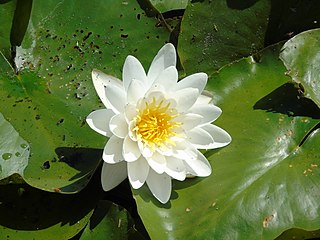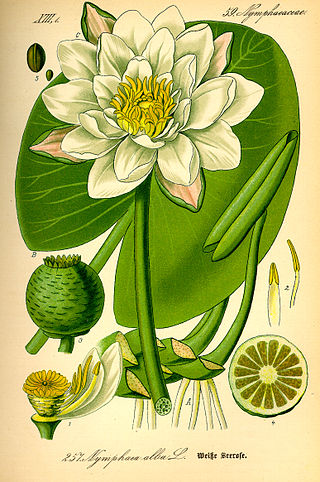
Nymphaeaceae is a family of flowering plants, commonly called water lilies. They live as rhizomatous aquatic herbs in temperate and tropical climates around the world. The family contains five genera with about 70 known species. Water lilies are rooted in soil in bodies of water, with leaves and flowers floating on or rising from the surface. Leaves are oval and heart-shaped in Barclaya. Leaves are round, with a radial notch in Nymphaea and Nuphar, but fully circular in Victoria and Euryale.

Victoria or giant waterlily is a genus of aquatic herbs in the plant family Nymphaeaceae. Its leaves have a remarkable size: Victoria boliviana produces leaves up to 3.2 metres (10 ft) in width. The genus name was given in honour of Queen Victoria of the United Kingdom.

Nymphaea is a genus of hardy and tender aquatic plants in the family Nymphaeaceae. The genus has a cosmopolitan distribution. Many species are cultivated as ornamental plants, and many cultivars have been bred. Some taxa occur as introduced species where they are not native, and some are weeds. Plants of the genus are known commonly as water lilies, or waterlilies in the United Kingdom. The genus name is from the Greek νυμφαία, nymphaia and the Latin nymphaea, which means "water lily" and were inspired by the nymphs of Greek and Latin mythology.

Nuphar is a genus of aquatic plants in the family Nymphaeaceae, with a temperate to subarctic Northern Hemisphere distribution. Common names include water-lily, pond-lily, alligator-bonnet or bonnet lily, and spatterdock.

Euryale ferox, commonly known as prickly waterlily, makhana, or Gorgon plant, is a species of water lily found in southern and eastern Asia, and the only extant member of the genus Euryale. The edible seeds, called fox nuts or makhana, are dried, and eaten predominantly in Asia.

Nymphaea mexicana is a species of aquatic plant that is native to the Southern United States and Mexico as far south as Michoacán. Common names include yellow water lily, Mexican water lily and banana water lily.
Nymphaea petersiana is a species of the genus Nymphaea native to the region spanning from Tanzania to South Africa.

Nymphaea subg. Brachyceras is a subgenus of the genus Nymphaea.

Nymphaea subg. Anecphya is a subgenus of the genus Nymphaea.

Nymphaea subg. Nymphaea is a subgenus of the genus Nymphaea.

Nymphaea subg. Lotos is a subgenus of the genus Nymphaea.

Nymphaea pygmaea is a controversial species of perennial, aquatic herb in the family Nymphaeaceae native to Asia.

Nymphaea sect. Chamaenymphaea is a section within the subgenus Nymphaea subg. Nymphaea of the genus Nymphaea native to North America, Asia, and Europe.
Euryale lissa is a fossil species of Euryale from the Pliocene of Brunssum, Limburg Province, Netherlands and from Höchst, Germany.
Euryale europaea is a fossil species of Euryale from the Pleistocene of Chekalin, Kaluga region, Russia, Belgium, and Bulgaria.
Euryale limburgensis is a fossil species of Euryale from the Pliocene of Tegelen, Limburg Province, Netherlands, from the lower Pleistocene of Greece, from the Pliocene and Pleistocene of Italy, and from the Pliocene of France.
Euryale carpatica is a fossil species of Euryale from the Pliocene of Krościenko nad Dunajcem, Poland.
Euryale akashiensis is a fossil species of Euryale from the Pliocene of Akashi, Hyōgo, Japan.
Euryale sukaczevii is a fossil species of Euryale from the Miocene of Omsk, Russia, and possibly Germany.
Euryale tenuicostata is a fossil species of Euryale from the Miocene of Omsk, Russia.














